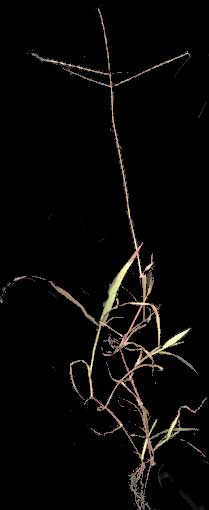
In your backyard the most commonly encountered, wild-growing grass may be crabgrass, shown at the right. About 200 species of crabgrass, genus Digitaria, are known, with 29 occurring in North America.

The crabgrass species at the right is Digitaria sanguinalis, usually just called "crabgrass," but sometimes named Hairy Crabgrass, to distinguish it from the other common, weedy crabgrass species in North America, Digitaria ciliaris, which is Smooth Crabgrass. The photo at the left shows the Hairy Crabgrass's hairiness. Smooth Crabgrass lacks the hairs.
In the picture at the right, note that the inflorescence of our Hairy Crabgrass is composed of a few spikelet-bearing branches at the stem's top, and the branch bases don't all merge with one another in one place. Also notice that the main stem is so spindly that it leans onto the ground, often rooting at its joints, or nodes.
Not all weedy grasses with similar inflorescences and weak steams are crabgrasses. Bermuda Grass, Goosegrass, Fingergrass, Carpet Grass and more do the same thing. Distinguishing them from crabgrass requires attention to details.

At the left you see a much-magnified view of a small section of the bottom side of one of Hairy Crabgrass's inflorescence branches. Note that it's the "bottom side," because these branches are flattish, with their spikelets on the bottom face. On the right side of that picture, two rows of teardrop-shaped spikelets press snugly up against the flattish branch axis, the "rachis."

Actually, the rachis's cross-section, more than "flat," is almost triangular in cross-section, or even T-shaped, thought it looks flat from the top. At the far left in the picture at the left, the spikelets have fallen off, leaving only their "stumps," of two different lengths. Between the two double rows of tall and short spikelet stumps, notice the wall-like bottom of the T of the T-shaped rachis cross-section surface.
These may seem worthlessly obscure details, but they're important to notice to be sure you have a crabgrass. Also, within the crabgrasses, the inflorescence branches vary as to whether they appear flat or triangular in cross-section. The branch axes, or rachises, of our Hairy Crabgrass bear thin "wings" along their sides, forming something like a little roof over the spikelets below them. At the right you can see a winged rachis from above.
Also in that photo is one last feature to keep in mind: Note how the winged rachis curves back and forth.